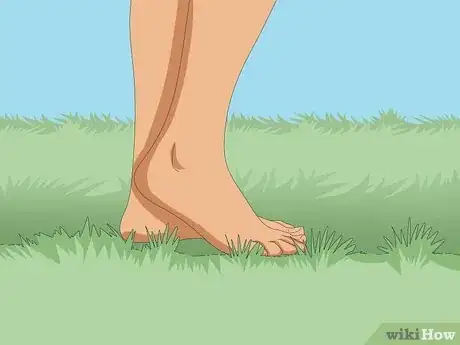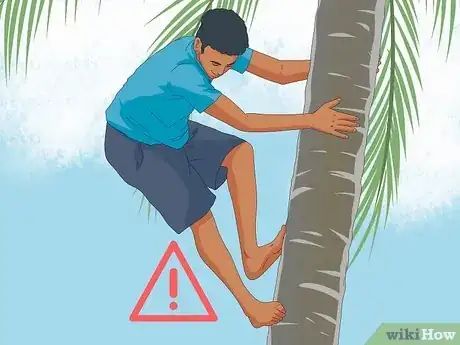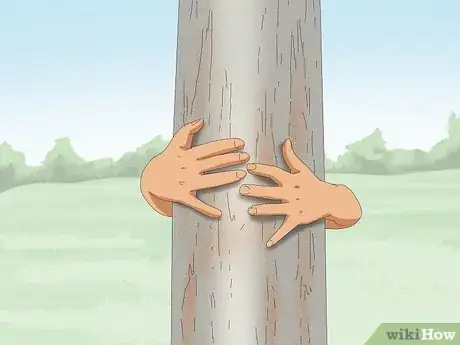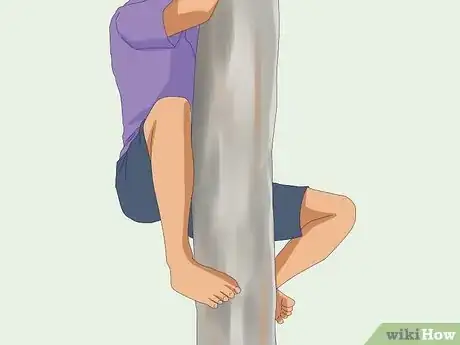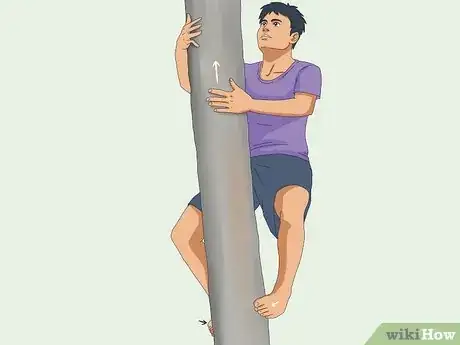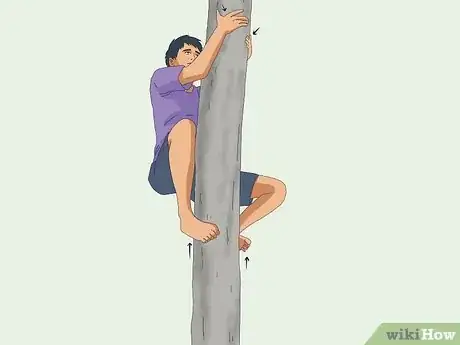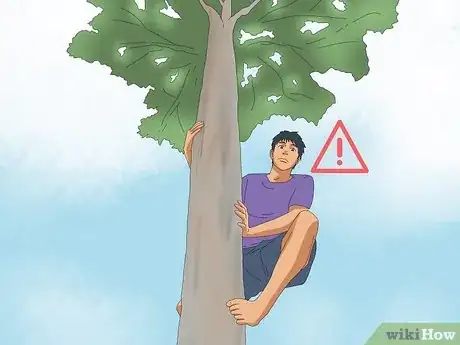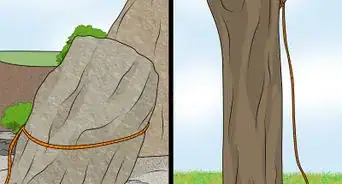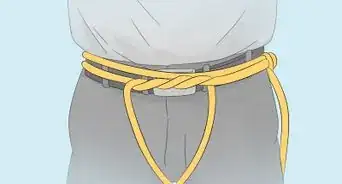This article was co-authored by wikiHow staff writer, Amber Crain. Amber Crain has been a member of wikiHow’s writing staff for the last six years. She graduated from the University of Houston where she majored in Classical Studies and minored in Painting. Before coming to wikiHow, she worked in a variety of industries including marketing, education, and music journalism. She's been a radio DJ for 10+ years and currently DJs a biweekly music program on the award-winning internet radio station DKFM. Her work at wikiHow supports her lifelong passion for learning and her belief that knowledge belongs to anyone who desires to seek it.
wikiHow marks an article as reader-approved once it receives enough positive feedback. In this case, 100% of readers who voted found the article helpful, earning it our reader-approved status.
This article has been viewed 259,644 times.
Learn more...
Climbing trees with no branches can be difficult, but as long as you do it safely, it can also be really fun! There are a couple of approaches you can take -- the front-foot technique and the frog technique. The front-foot technique is best for skinny trees, like coconut trees. The frog technique can be used for trees that are a little wider. Use caution, since you can get hurt climbing any tree, branches or not.
Steps
Using the Front-Foot Technique
-
1Check out the tree from all sides. Before you start climbing, inspect the tree for any safety hazards or things you'll need to navigate around, like knots, rotting spots, and holes. If the tree looks damaged, avoid it. This technique works best on skinny trees that you can grasp with both hands, like coconut trees, so take a closer look at the size, too.[1]
- You should be able to place your hands close to each other on the opposite of the tree, almost like you're giving it a hug, with plenty of room to lift your foot and place it on the front side of the trunk.[2]
- Avoid trees with smooth bark, since it's hard to get a good grip on those.
-
2Remove your socks and shoes. Putting your bare feet onto the tree will give you the most control over your movements. Don't wear flip-flops or any type of sandal, since these can become safety hazards as you climb. It's best to wear athletic clothing so that you can move around freely, but it's not required.[3]Advertisement
-
3Place your hands on the backside of the tree. If you can't easily do this, the tree isn't skinny enough to use this technique. Place one hand slightly above the other on the opposite side of the trunk, and press your palms into the bark. With your arms fully extended, grip the tree with the palms of both hands.[4]
- It will sort of feel like you're about to dance with the tree!
- Do not place your hands on top of one another or on the sides of the tree.
-
4Place your dominant foot flat against the trunk in front of you. Lean back a little, using your grasp on the tree to keep you upright. Press the sole of your dominant foot flat against the trunk. Your knee should be bent and almost touching your chest. Use your grip on the backside to balance yourself, since you only have 1 foot (0.30 m) on the ground now.[5]
-
5Use your arms to pull your foot off the ground and onto the tree. Lean back, then pull your your body up and toward the tree with your arms. Keep pulling until your non-dominant foot starts to leave the ground. Keep leaning back! Quickly pull your non-dominant foot up and place it against the tree.
- At this point, you should be using your arms to support your weight as you hang from them. Use your feet to balance yourself. Keep your knees slightly bent.
-
6Begin walking up the tree trunk. Set your second foot above the first, putting pressure into the tree with the balls of your feet. Put one foot in front of the other, taking 1-2 tiny steps up the trunk. Remember to stay leaning back, hanging from your arms, while putting all of the pressure onto your feet.[6]
-
7Let go with one hand and grab the trunk a few inches up. Then use the opposite hand to do the same thing, grabbing the trunk right above the first hand. Whenever you let go with one hand, stay stable by continuing to put pressure on your feet.
-
8Continue alternating your feet and hands to move up the tree. Scurry up the trunk a little bit at a time, creating a counterbalance between your hands and feet as you climb. Try to keep your hands and feet as close to each other as possible. Don't pull yourself too far up without immediately taking a few small steps to close the distance.[7]
-
9Descend slowly and with caution. Climb down the tree in the same way you came up, placing one foot below the other and then moving your hands down a few paces to close the distance. Place each foot onto the tree carefully. Keep the counterbalance between your arms and feet as you descend.
- Maintaining the pressure on the balls of your feet is very important when descending, as going down will be more awkward for your body.[8]
Using the Frog Technique
-
1Inspect the tree closely. Look for any safety hazards or things you'll need to climb around, like knots, rotting spots, insect infestations, bark damage, and holes. This technique works best on steep vertical trees that you're able to get your arms around.[9]
-
2Place your hands on the sides of the tree. Remove your sock and shoes. Place your arms around the tree, pushing your palms into the backside and gripping it with your palms and fingers. Lean back a little, and let the weight of your body hang slightly on your arms.[10]
-
3Jump onto the tree, placing the soles of your feet on either side of it. While keeping a good grasp on the tree, bend your knees slightly and jump high enough to get your legs up to grip the tree with the soles of your feet. Your feet should be horizontal, gripping the width of the tree, rather than vertical, like in the front-foot technique.
- Keep your knees bent and your hands in place. Support your body weight with your legs and arms.
- When you're in this crouched position with knees and arms bent, you'll look a lot like a frog, which is where the technique gets its name![11]
-
4Grip the trunk with your feet and push yourself up with your legs. Using your thighs and hips, extend your legs as if you were standing up. Keep your hips and chest close to the tree, and move your hands up the trunk, one at a time, as you straighten out your body.
- Always keep your grip on the tree with one hand as you let go with the other one.
-
5Pull up with your arms and slide your feet up quickly the trunk. Supporting yourself with your arms, pull your body up and push off the trunk with your feet. As soon as you extend your legs, bring your knees up while gripping the tree with your hands. You will look sort of like a frog jumping! Grasp the tree again with your feet, squeezing the trunk as you support yourself.[12]
- Your hands, arms, and chest should work in tandem with one another, and your feet should stay close to the tree when you pull and hop.
- At this point, you may want to rest for a moment and catch your breath before your next hop!
-
6Repeat these movements until you have climbed up the tree. Once you are back in the crouching position, extend your legs again, bringing you higher up the tree's trunk. Move your hands up the trunk and grip it. Then pull and hop. Climb the tree slowly, taking your time and focusing on each new movement.
-
7Descend the tree slowly, one hand at a time. Lower your hands, one by one, as if you were climbing down a ladder. As you descend, slide your feet carefully down the bark, never losing contact with the trunk. Unless you have really tough soles, the bottoms of your feet are going to get a bit roughed up as you do this![13]
- Your descent should be made in slow, sequential movements and done carefully, especially when you are high up in the tree.
Community Q&A
-
QuestionHow to get down from the tree?
 Community AnswerIf it is not more than three feet taller than your height, jump. If it is taller than that, get a good grip on the tree and slowly climb down. See further: How to Climb a Tree.
Community AnswerIf it is not more than three feet taller than your height, jump. If it is taller than that, get a good grip on the tree and slowly climb down. See further: How to Climb a Tree. -
QuestionHow do I climb my awesome tree with big limbs and some branches attached to the limbs?
 Community AnswerGrab the branches and pull yourself up, then step on or do the same to the next limbs up. See further: How to Climb a Tree.
Community AnswerGrab the branches and pull yourself up, then step on or do the same to the next limbs up. See further: How to Climb a Tree. -
QuestionCan I climb barefoot?
 Community AnswerYes, and some people prefer to do that because your feet can provide excellent grip. Keep in mind though that it's possible to get splinters or cuts this way, so be careful.
Community AnswerYes, and some people prefer to do that because your feet can provide excellent grip. Keep in mind though that it's possible to get splinters or cuts this way, so be careful.
References
- ↑ https://www.youtube.com/watch?v=RkuCshpcevU
- ↑ https://ambergriscaye.com/cocopalms/climbing.html
- ↑ https://ambergriscaye.com/cocopalms/climbing.html
- ↑ https://www.youtube.com/watch?v=RkuCshpcevU
- ↑ https://www.youtube.com/watch?v=RkuCshpcevU
- ↑ https://www.youtube.com/watch?v=RkuCshpcevU
- ↑ https://www.youtube.com/watch?v=RkuCshpcevU
- ↑ https://ambergriscaye.com/cocopalms/climbing.html
- ↑ https://ambergriscaye.com/cocopalms/climbing.html
About This Article
Before you try climbing a tree with no branches, check both sides for any hazards, such as knots or holes, which could cause you to stumble while climbing. Then, take off your socks and shoes for better grip, and put your hands on the back of the tree. Next, lean back a little, place the sole of your dominant foot flat on the tree, then use your arms to pull your other foot off the ground. Continue leaning back as you alternate your arms and feet to climb up the tree, making sure to use your arms to support your weight. For tips on how to use the frog technique to climb a tree and how to descend safely, read on!

